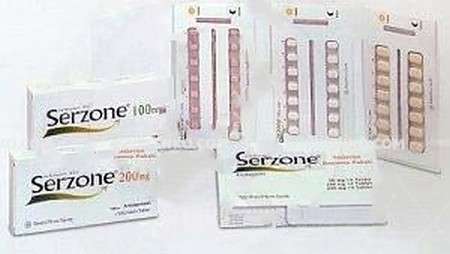Serzone Tablet 200 Mg
Serzone Tablet 200 mg, also known as Nefazodone, is a widely used antidepressant medication that effectively addresses chemical imbalances in the brain causing depression. This article provides valuable insights into the dosage, availability, uses, warnings, interactions, and potential side effects.
| Dosage form | |
|---|---|
| Pack size | |
| Potency | 200 Mg |
| Manufacturer | |
| Origin | |
| Generic Name (Ingredient) | Serzone? 200 Mg Tablets: 200 Mg Of Nephazodone Hydrochloride And Other Auxiliaries As Well As Yellow Iron Oxide. |
Assuming your emergency circumstances for this product, visit Urgent Quotation page. Besides, for any pharmaceutical questions, please ask us in the comments section.
Description
Dosage and Administration
To initiate treatment with Serzone, it is recommended to start with a daily dosage of 200 mg, administered in two divided doses. This ensures optimal absorption and effectiveness of the medication.
Availability and Composition
Serzone is available in the form of hexagonal tablets with various strengths: 50 mg, 100 mg, 150 mg, 200 mg, and 250 mg. Each tablet contains nefazodone hydrochloride along with inactive ingredients such as microcrystalline cellulose, povidone, sodium starch glycolate, colloidal silicon dioxide, magnesium stearate, and iron oxides (red and/or yellow) for coloration.
Uses of Serzone
Serzone is primarily prescribed to alleviate symptoms associated with depression. These symptoms include persistent feelings of sadness, worthlessness, guilt, loss of interest in daily activities, changes in appetite, excessive tiredness, insomnia, and even thoughts of death or suicide. Serzone can help patients regain a sense of well-being and improve their quality of life. It’s important to note that Serzone may also have uses beyond those explicitly mentioned in this medication guide.
Important Warnings
While Serzone offers significant benefits for treating depression, it is essential to be aware of potential risks and side effects. In rare cases, the use of Serzone has been linked to severe liver problems, occasionally necessitating liver transplants or leading to fatal outcomes.
It is crucial to promptly inform your doctor if you observe any of the following symptoms: yellowing of the skin or eyes, unusually dark urine, loss of appetite lasting for several days or longer, severe nausea, or stomach pain. Identifying and addressing these symptoms early can help mitigate potential liver problems.
Drug Interactions
Serzone can interact with medications metabolized by cytochrome P450 3A4, as nefazodone inhibits this particular enzyme. Noteworthy drugs that fall under this category include triazolam, alprazolam, calcium channel antagonists, terfenadine, astemizole, ketoconazole, and erythromycin. It is important to consult your healthcare provider or pharmacist to ensure that any potential drug interactions are evaluated and managed effectively.
Potential Side Effects
While Serzone is generally well-tolerated, some common side effects may occur. These include dizziness, drowsiness, lightheadedness, headache, weakness, nausea, dry mouth, and sore throat. It is important to note that in rare cases, Serzone treatment has been associated with severe liver problems, which can manifest as yellowing of the skin or eyes, dark urine, prolonged loss of appetite, severe nausea, or stomach pain.
If you experience any of these symptoms, it is crucial to seek immediate medical attention to assess and address the possibility of liver complications.
Increased Risk of Suicidal Thoughts
Antidepressant medications, including Serzone, may increase the occurrence of suicidal thoughts or behaviors in certain individuals. If you notice any changes in your thought patterns or behavior while taking it, it is crucial to inform your doctor promptly. They can provide appropriate support and monitor your response to the medication closely.
Conclusion
Serzone Tablet 200 mg (Nefazodone) is a trusted antidepressant medication used to treat depression effectively. By regulating chemicals in the brain, it helps alleviate symptoms such as sadness, loss of interest, and changes in appetite. While taking it, it is important to be vigilant for potential side effects and promptly report any concerning symptoms, especially those related to liver function.
Additionally, informing your healthcare provider about any changes in mood or behavior will ensure the appropriate management of your treatment. Remember, the ultimate goal of it is to help you achieve a better quality of life and regain emotional well-being.
Use the form below to report an error
Please answer the questions as thoroughly and accurately as possible. Your answers will help us better understand what kind of mistakes happen, why and where they happen, and in the end the purpose is to build a better archive to guide researchers and professionals around the world.
The information on this page is not intended to be a substitute for professional medical advice, diagnosis, or treatment. always seek the advice for your physician or another qualified health provider with any questions you may have regarding a medical condition. Always remember to
- Ask your own doctor for medical advice.
- Names, brands, and dosage may differ between countries.
- When not feeling well, or experiencing side effects always contact your own doctor.
Cyberchondria
The truth is that when we’re sick, or worried about getting sick, the internet won’t help.
According to Wikipedia, cyberchondria is a mental disorder consisting in the desire to independently make a diagnosis based on the symptoms of diseases described on Internet sites.
Why you can't look for symptoms on the Internet
If diagnoses could be made simply from a textbook or an article on a website, we would all be doctors and treat ourselves. Nothing can replace the experience and knowledge of specially trained people. As in any field, in medicine there are unscrupulous specialists, differences of opinion, inaccurate diagnoses and incorrect test results.





Reviews
There are no reviews yet.